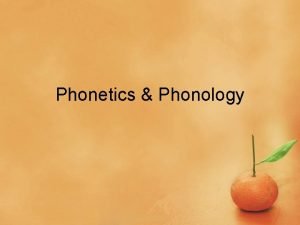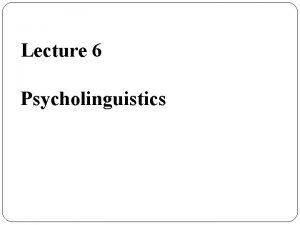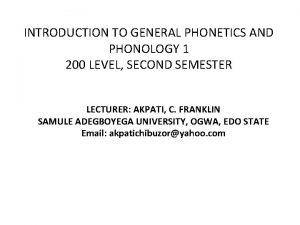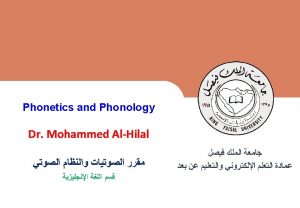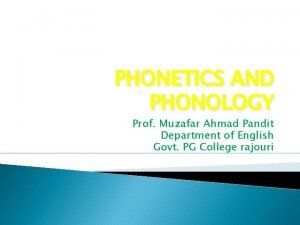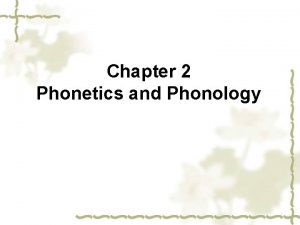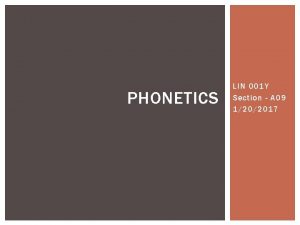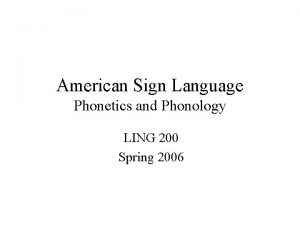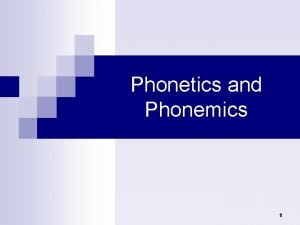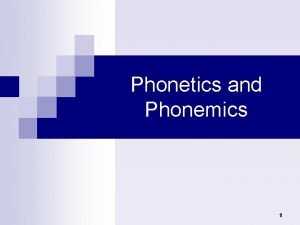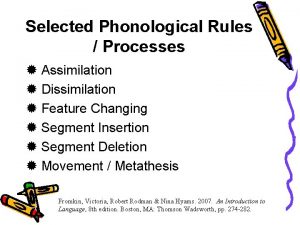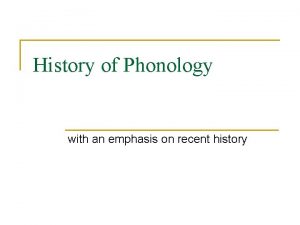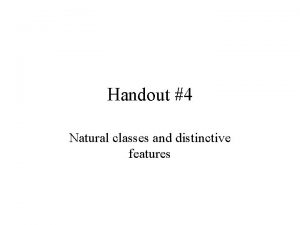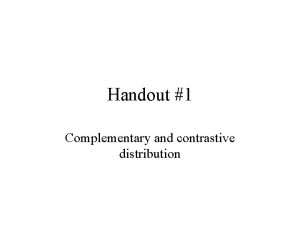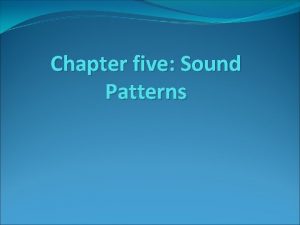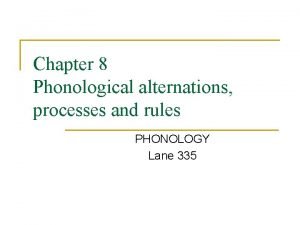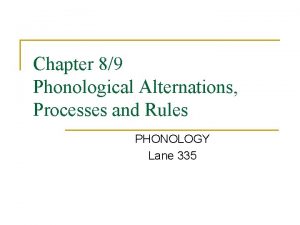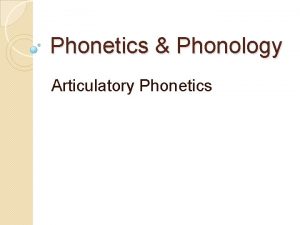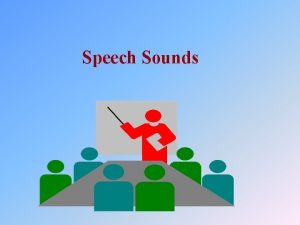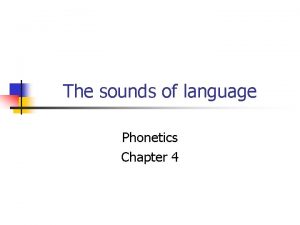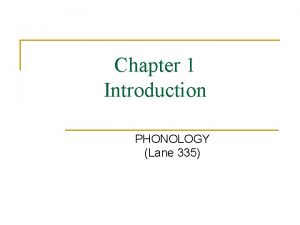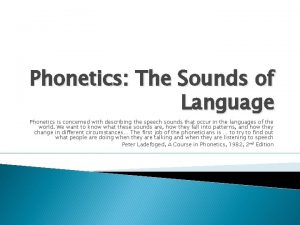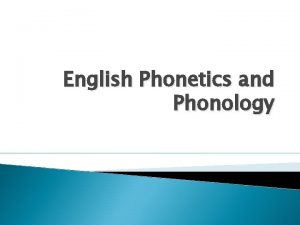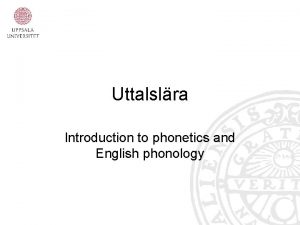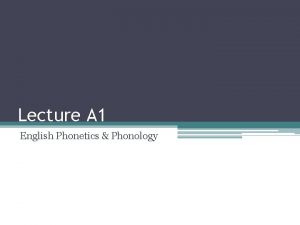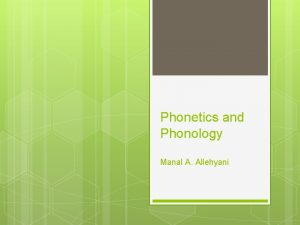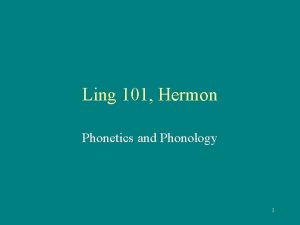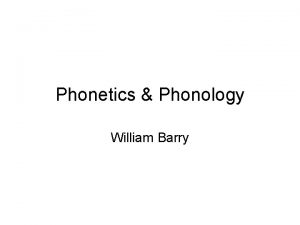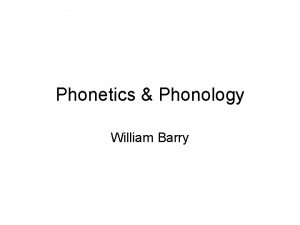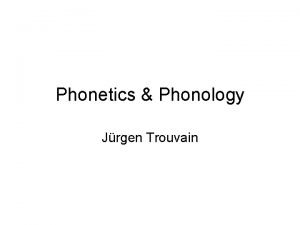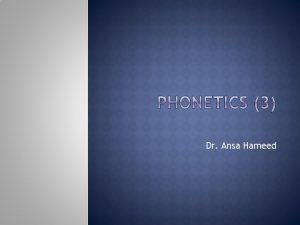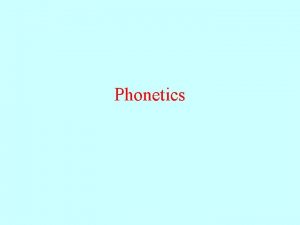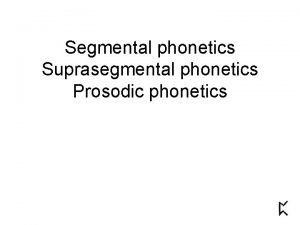Chapter 2 Sounds of Language Phonetics and Phonology































![Fricatives • Alveolar fricative [z] as in zero. • Alveopalatal [ ] as in Fricatives • Alveolar fricative [z] as in zero. • Alveopalatal [ ] as in](https://slidetodoc.com/presentation_image_h2/807b45187531f5aa036c5471af5becfa/image-32.jpg)

![Laterals • Phones like the initial [L] in laugh are called laterals because the Laterals • Phones like the initial [L] in laugh are called laterals because the](https://slidetodoc.com/presentation_image_h2/807b45187531f5aa036c5471af5becfa/image-34.jpg)


- Slides: 36

Chapter 2 Sounds of Language Phonetics and Phonology Text: Linguistics An Introduction William B. Mc. Gregor Prepared by Dr. Abdullah S. Al-Shehri 1

Goals The goals of this chapter are: • Describe the basic structure of the speech organs or vocal tract. • Explain how speech sounds are produced. • Identify the main types of speech sounds and how they are classified. • Present the essential of the main system for representing speech sounds, the IPA. 2

Goals • Outline the basic prosodic properties of speech (pitch, tone, intonation, stress) and how they are used in different languages. • Explain the notions of phoneme and allophone. • Show to determine the phonemes of a language. • Describe the major methods of transcribing speech. 3

Key Terms • • Acoustic phonetics Allophone Articulatory phonetics Auditory phonetics Click Complementary distribution Consonant Diphthong 4

Key Terms • • Ejective Free variation Glottal airstream Implosive International Phonetic Alphabet Intonation Manner of articulation 5

Key Terms • • Minimal pair Phoneme Pitch Place of articulation Pulmonic airstream Stress Suspicious pair 6

Key Terms • • Syllable Tone Velaric airstream Vocal tract Voicing Voice onset time Vowel 7

Fundamental properties of speech sounds The speech chain model (presented in Denes and Pinson 1973) identifies the following steps in conveying a message from a speaker to a hearer. 1. A thought emerges in the brain of the speaker and is encoded in language. 2. Messages are sent through nerves from the brain to the vocal apparatus (muscles and organs that act together to produce speech sounds). 3. The muscles and organs are positioned and set into motion. (Articulatory phonetics) 8

Fundamental properties of speech sounds 4. 5. 6. 7. 8. As a result, sounds that are produced travel through the air. (Acoustic phonetics) These sounds reach the ears of the hearer, which ‘process’ the sounds, converting them into electrical signals. (auditory phonetics) These electrical signals travel along the auditory nerves to the hearer’s brain. The brain of the hearer decodes these impulses. At the same time, the speaker’s utterance reaches the (speaker’s) ear, and is converted to electrical signals that travel to the (speaker’s) brain, to be decoded and compared with intended utterance. 9

Fundamental properties of speech sounds Processes 3, 4. and 5 are the main concerns of phonetics: • Articulatory phonetics (production of sounds). • Acoustic phonetics (physical properties of sound) • Auditory phonetics (perception of speech sounds) This chapter deals mainly with articulatory phonetics. 10

Phones • An utterance is a sequence of phones (sounds). • Breaking an utterance into phones is a reasonable approximation. • Phones are represented in writing. • We use International Phonetic Alphabet (IPA) for this purpose. • IPA is a set of symbols based on Latin alphabet. 11

The Vocal Tract • The organs involved in producing the sound of speech are referred collectively as the vocal tract: • • The lungs The larynx The oral cavity The nasal cavity 12

The lungs • Sounds of most languages are produced on egressive pulmonic airstream (air is pushed out of the lungs). • Some languages use ingressive pulmonic airstream (air is drawn into the lungs). 13

The larynx • The airstream passes between a pair of muscular flaps (vocal folds or cords) producing either voiced or voiceless phones. • Voiced phone: /th/ in then. • Voiceless phone: /th/ in thin. 14

The oral cavity • After travelling through the larynx, the airstream passes through the oral cavity (mouth) and/or nasal cavity (nose). • In the oral cavity the airstream is modified in many different ways to produce many different speech sound. • The main sound modifying organs are the tongue and lips. 15

The nasal cavity • At the back of the roof of the moth is the velum (or soft palate). • It can be raised or lowered. • When lowered, the airstream enter through the nasal cavity, such as when pronouncing ‘man’. • When raised, the airstream enter through the oral cavity, such as when pronouncing ‘bad’. 16

Types of phones Speech sounds are divided into two main types: 1. Consonants: sounds produced as the airstream is interrupted in the oral cavity and are described in relation to the point where air is impeded and how it is impeded (place and manner of articulation). 2. Vowels: sounds produced with no significant obstruction of air in the oral cavity. 17

Consonants Types of consonants according to places of articulation: • • • Labial Dental Interdental Alveolar Palatal Velar Uvular Pharyngeal Glottal 18

Consonants Types of consonants according to manner of articulation: • • Stops Nasals Fricatives Affricates Laterals Rhotics Glides 19

Labials • Labials are sounds made with the lips. • If both lips are used (upper and lower lip come together), the sound is called bilabial (pad, mad, bad). • Labiodentals are when the lower lip touches the upper teeth ( fix, very). 20

Dentals • Dentals are formed with the tongue and the upper teeth, or when the tongue protrudes between the upper and the lower teeth (interdentals) as in three, this: IPA [ᶿ] and [ ]. 21

Alveolar • Sounds made with the front part of the tongue, touching the alveolar ridge (front roof of the mouth) are called alveolars (top, dog, log, rag, sag). • If the tip of the tongue makes contact just behind the alveolar ridge, the sound is called post-alveolar or retroflex. 22

Palatal • The palate (or hard palate) is the large area of the roof of the mouth extending from behind the alveolar ridge to the soft palate (velum). • Sounds made with contact between the tongue and the palate are called palatals (Hungarian nyak, gyufa). • If contact is in the front part of the palate, behind the alveolar ridge, the sound is called alveo-palatal (shingle, jungle, child). 23

Velar • The velum (or soft palate) is a soft area located behind the hard palate. • Consonants made with the back of the tongue touching the velum are called velar sounds: IPA [k/g]. • The English words can, kill, go begin with velar sounds; the word sing ends with a velar also: IPA [ᵑ] 24

Uvular • At the back of the velum is a hanging appendage called the uvula: • The sounds made with the back of the tongue touching the uvula are called uvulars. • The r-sound in Parisian French and German are uvular trills: IPA [R]. 25

Pharyngeal • The pharynx is the chamber behind the back of the tongue, above the larynx. • Pharyngeal consonants are made by pulling the root of the tongue back to narrow the pharynx making the air pass through noisily. • Pharyngeal sounds are found in Arabic: [ ﻉ / ]ﺡ. 26

Glottal • Glottal consonants involve a constriction of the glottis (opening between the vocal cords). • Glottal stops are produced by holding the vocal cords together and then releasing them. • The Arabic sound [ ]ﺀ is a glottal stop. • The initial sounds of the English words hot and hill are also glottal fricatives. 27

Manners of articulation Seven main manners of articulation are used in human languages: • Stops • Nasals • Fricatives • Affricates • Laterals • Rhotics • Glides 28

Stops • A phone that has complete blockage of the airstream at any point in the vocal tract is a stop or plosive. • At the beginning of the words bed and pet, the bilabial sounds [b]and [p] involve complete closure of the airflow, followed by a sudden release of air. • Other stops are [t], [d], [k], [g]… 29

Nasals • Nasals are phones which are produced by lowering the velum to permit to flow through the nose: [m], [n]. • Nasals are like stops in having a complete blockage of the air through the oral cavity. • For the [m] there’s a complete closure of the oral cavity at the lips, but the velum is lowered to allow air to travel through the nose. 30

Fricatives • Fricatives are produced with incomplete closure at any place of articulation in the vocal tract from the lips to the glottis. • English has the following voiced and voiceless fricatives: • Voiced labiodental fricative [v] as in valley. • Voiceless labiodental fricative [ f] found. • Dental fricative [ ᶿ] as in thin. • Dental fricative [ð] as in then. • Aleveolar fricative [S] as in sand. 31
![Fricatives Alveolar fricative z as in zero Alveopalatal as in Fricatives • Alveolar fricative [z] as in zero. • Alveopalatal [ ] as in](https://slidetodoc.com/presentation_image_h2/807b45187531f5aa036c5471af5becfa/image-32.jpg)
Fricatives • Alveolar fricative [z] as in zero. • Alveopalatal [ ] as in share. • Alveopalatal [ ] as in jail. • Glottal fricative [h] as in hat. Other languages have the velar fricative [x] as in German [bux] “book” and Arabic [xail] ﺧﻴﻞ 32

Affricates • Affricates are phones produced by combining a stop and a fricative. • English has two alveopalatal affricates: • Voiceless [ ] as in church, and • Voived [ ] as in jungle. 33
![Laterals Phones like the initial L in laugh are called laterals because the Laterals • Phones like the initial [L] in laugh are called laterals because the](https://slidetodoc.com/presentation_image_h2/807b45187531f5aa036c5471af5becfa/image-34.jpg)
Laterals • Phones like the initial [L] in laugh are called laterals because the sides of the tongue are lowered at the point of articulation, allowing air to pass on both sides of a central closure. • The alveolar ridge region is the most common point of articulation for laterals. • Other types of laterals are found in world languages with different points of articulation: dental, post alveolar, retroflex. . 34

Rhotics • The term rhotic is used for r-like sounds which are represented in IPA with [r]. • The main rhotics are taps (or flaps), trill, and approximates. • Taps involve a single rapid short closure, between the tip of the tongue and the teeth or alveolar ridge: Spanish pero [ ]‘but’. • Trills consist of two or more rapid taps and are produced with the tip of the tongue: Spanish perro [ ] ‘dog’. • Rhotic approximants involve proximity, rather than contact, at the place of articulation. 35

Glides (Semivowels) • Glides (semivowels) are vowel-like consonants, with very little constriction at the point of articulation. • The y-sound of English, IPA [j], is a glide in which the blade of the tongue moves towards the palate or the teeth. • English has a second glide, the labiovelar [w], which is produced by moving the back of the tongue towards the velum while rounding the lips. 36
 Allophones example
Allophones example Difference between phonetics and phonology
Difference between phonetics and phonology Onset coda and nucleus
Onset coda and nucleus Phonetics and phonology
Phonetics and phonology Introducing phonology answer key
Introducing phonology answer key Difference between phonetics and phonology
Difference between phonetics and phonology What is phonology in linguistics
What is phonology in linguistics Introduction to general phonetics and phonology
Introduction to general phonetics and phonology Phonemes and symbols
Phonemes and symbols Elearning
Elearning Phonetics and phonology
Phonetics and phonology Complementary distribution examples
Complementary distribution examples S phonetic alphabet
S phonetic alphabet Oral sounds and nasal sounds
Oral sounds and nasal sounds Diphthongs sounds are the combination of two vowel sounds
Diphthongs sounds are the combination of two vowel sounds Minimal pair asl
Minimal pair asl Discourse analysis and phonology
Discourse analysis and phonology Peaking intonation
Peaking intonation Phonetically pronunciation
Phonetically pronunciation Phonetics and phonemics
Phonetics and phonemics Dissimilation definition
Dissimilation definition Unsuz benzesmesi
Unsuz benzesmesi Whats an allophone
Whats an allophone Phonology process
Phonology process Non segmental phonology
Non segmental phonology Autosegmental phonology
Autosegmental phonology Natural classes phonology
Natural classes phonology Complementary distribution definition
Complementary distribution definition Distinctive feature theory in phonology
Distinctive feature theory in phonology Phonology process
Phonology process Segment insertion and deletion rules
Segment insertion and deletion rules Alternation in phonology
Alternation in phonology Natural classes phonology
Natural classes phonology Garden path sentence explanation
Garden path sentence explanation Linking in phonology
Linking in phonology Subsystems of language
Subsystems of language Alpha notation phonology
Alpha notation phonology



